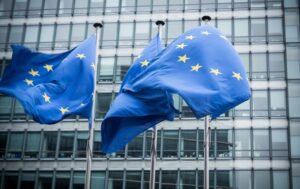
In July 2025, Express Insurance settled insurance claims under CASCO contracts in Bulgaria, Spain, Italy, Latvia, Moldova, Germany, Poland, Slovakia, France, and the Czech Republic.
According to the company’s website, the total amount of payments reached UAH 1.883 million.
It should be noted that in most cases, these were traffic accidents or damage caused by unlawful actions of third parties.
For example, a nighttime encounter with a wild moose while traveling between settlements in Poland resulted in damage to the hood, front bumper, right front door, mirror, windshield, and other elements of the front of the car. The company paid out UAH 1.1 million.
In addition, the company paid UAH 271,800 for damage to the windshields of customers traveling on the roads of Spain, Italy, Germany, and Poland caused by stones flying out from under the wheels of other cars.
While driving out of one of the streets in the old part of Barcelona, a customer accidentally hit a fence and a curb, damaging the front bumper, right rear fender, and plastic trim under the right sill. The CASCO payment amounted to over UAH 40,000.
Express Insurance was founded in 2008. It is part of the UkrAVTO group of companies. It specializes in car insurance. The consistently high speed of settlement of claims at the insurance company is ensured by optimal interaction with partner service stations.

As of August 1, 2025, Ukraine has exhausted its ability to export dry milk to the European Union, with butter and milk fats next in line, whose quotas will be exhausted in the third decade of August, according to Ekonomichna Pravda, citing information from the Ukrainian Dairy Industry Association (SMU).
“As of August 1, there is no possibility of exporting dry milk originating in Ukraine to the EU within the quotas. According to the European Commission, as of July 30, the quota (including volumes expected to be allocated) was more than 91% filled, with only about 0.28 thousand tons remaining out of a quota of 2.92 thousand tons,” the publication said.
According to the industry association, the volumes of dry milk already awaiting clearance at the EU border exceed the available quota. From August 1, it no longer makes economic sense to send consignments of dry milk to the EU – they will have to be returned.
Quotas for imports of butter and milk fats to the EU will last a little longer. Currently, they are already more than two-thirds full. If butter exports to the EU remain at the same level in the coming weeks, the quota could be filled by the beginning of the third decade of August.
“The changes have already affected milk prices in Ukraine: in the second half of July, they rose by more than 5%. The reason for this is an attempt by processors to make a profit before the quotas are exhausted. This market trend may change if Brussels does not take new decisions on quotas,” the SMU emphasized.

In 2024, the Metinvest mining and metallurgical group reduced its rolled steel production in the UK and the EU by 13% to 1.367 million tons, which was caused by unfavorable market conditions in the EU, in particular the availability of cheap Russian slab, according to the group’s annual report.
According to the report, flat steel production at Metinvest Trametal decreased by 3% to 466,000 tons, at Ferreira Valsider by 45% to 190,000 tons, and at Spartan UK by 22% to 153,000 tons.
Overall, Trametal accounted for 34% of total production in the UK and the EU last year (31% in 2023), Ferreira Valsider for 14% (22%), Promet Steel for 41% (35%), and Spartan for 11% (12%).
As reported, in 2024, Metinvest reduced sales of finished metallurgical products by 5% compared to the previous year, semi-finished products by 3%, but increased coke sales by 6%, and sales of other products and services increased by 33%.
Revenue from the metallurgical segment remained virtually unchanged compared to 2023 and amounted to $4.824 billion, while the segment’s share in consolidated revenue decreased by 6 percentage points (pp) to 60%.
At the same time, sales of merchantable pig iron decreased by 15% to $266 million due to a 16% reduction in shipments to 558 thousand tons. In particular, the reduction in resales and production volumes of the group amounted to 12% and 52%, respectively. The share of resales in total sales increased by 4 p.p. to 95%. North America and Europe remained the main markets for this product. They accounted for 71% and 23% of total shipments last year, compared with 70% and 26% in 2023.
Sales of semi-finished products increased by 9% last year to $389 million, thanks to a 16% increase in sales volumes to 716,000 tons amid a reduction in inventories. Shipments to the Middle East and North Africa (MENA) increased by 237,000 tons, accounting for 50% of total shipments in 2024 (20% in 2023). In contrast, shipments to Europe decreased by 143,000 tons and accounted for 38% of total sales (68% in 2023). The average selling price declined in line with the dynamics of CFR Turkey square billet prices (down 7% compared to 2023).
In 2024, flat steel sales declined by 6% to $2.244 billion. This was due to lower sales prices following the dynamics of the corresponding benchmark for hot-rolled coils CFR Italy, which fell by 9%. Total shipments increased by 7% to 3.047 million tons, driven by a 26% increase in resales to 2.111 million tons, which increased their share in total shipments to 69% (up 10 percentage points). Deliveries were primarily to Europe, which accounted for 72% of the total (71% in 2023). Sales in the region increased by 193,000 tons thanks to demand from key customers, expansion of the customer base, and stable operations at Black Sea ports. Domestic sales accounted for 23% of sales (25% in 2023).
Sales of long products remained unchanged in 2024 at $948 million. Shipments increased by 5% to 1.372 million tons, primarily due to higher production volumes at Kametstal. Ukraine and Europe remained the main markets for these products. They accounted for 45% and 35% of total sales, respectively, compared with 48% and 39% in 2023. The Group increased its shipments to North America, which accounted for 17% of total sales in 2024, compared with 12% a year ago. Average sales prices declined in line with the benchmark for CFR Turkey square billets.
The report notes that in 2024, Metinvest achieved significant results from operational improvements. In particular, in the metallurgical segment, coke consumption at Kametstal was reduced and blast furnace productivity was improved thanks to the rapid adaptation of pulverized coal injection technology to alternative types of coal under military supply restrictions. In addition, the optimization of raw material procurement contributed to the positive results.
Metinvest is a vertically integrated group of mining and metallurgical companies. Its enterprises are located in Ukraine, in the Donetsk, Luhansk, Zaporizhia, and Dnipropetrovsk regions, as well as in the European Union, the United Kingdom, and the United States. The main shareholders of the holding company are SCM Group (71.24%) and Smart Holding (23.76%). Metinvest Holding LLC is the management company of the Metinvest Group.
EU, METINVEST, PRODUCTION, rolling, UK

Ukrainian farmers reduced sugar beet acreage in 2025 by 15.4% compared to last year, to 220,000 hectares, according to First Deputy Minister of Agrarian Policy and Food Taras Vysotsky.
“The Ministry of Agrarian Policy’s estimate (of sugar beet acreage – IF-U) stands at 220,000 hectares, compared to 259,000 hectares last year. We have a guaranteed 15% decline,” he said at a meeting of the Trend&Hedge Club.
When asked whether the European Union’s trade policy had influenced this situation, Vysotsky noted that this was definitely the reason for the decline in production of this crop.
He stressed that Ukrainian processors were very disappointed with the sugar supply volumes to the EU announced in spring 2025, which amounted to 67,000 tons for 2025. Currently, this supply threshold has been raised to 107,000 tons. However, at its peak, supplies to the EU reached 473,000 tons, so when comparing the allocated quota with the peak supply volume, the difference is obvious.
“In fact, the renaissance of the sugar industry in Ukraine was due to duty-free trade with the EU. Then, thanks to the scale and turnover, our producers began to enter other export markets, but the starting point was access to the European market, which has the highest margins. There are no alternatives in terms of margins,” the deputy minister said.
Vysotsky did not rule out that the area under sugar beet cultivation would continue to decline in the coming years. At the same time, he noted that all decisions on this matter would be made by producers taking into account export prospects, particularly to the EU.

European leaders and industry circles have reacted strongly to US President Donald Trump’s announcement that he will impose 30% tariffs on imports from the EU from August 1, a significant increase on the current 10% base rate, according to Euractiv.
According to the publication, the decision has caused outrage among EU member state leaders, who are calling for an immediate and tough response from Brussels. European diplomats will hold an emergency meeting on Sunday to discuss measures
Bernd Lange, chairman of the European Parliament’s Trade Committee, called Washington’s actions “arrogant and a slap in the face” and said that countermeasures should take effect as early as Monday.
French President Emmanuel Macron called on the European Commission to resolutely defend the EU’s interests if no agreement is reached by August 1.
Spanish Prime Minister Pedro Sánchez noted the strength of the single market, while Italian Prime Minister Giorgia Meloni expressed hope that escalation could be avoided.
Hungary criticized the European Commission, saying that tariffs should have been lowered after Trump’s return.
Meanwhile, representatives of European industry are warning of serious consequences of the new tariffs. The Federation of German Industries (BDI) called Trump’s statement “an alarm bell” and called for a quick solution to avoid further escalation. According to official data, German exports to the US have already fallen to their lowest level since March 2022,” the statement said.
The food industry, particularly the wine sector, is particularly affected. The Italian wine association UIV said the new tariffs could lead to an embargo on 80% of Italian wine exports to the US. “This is the darkest page in the relationship between two historic allies,” said UIV President Lamberto Frescobaldi.

Preferential roaming between Ukraine and the EU will remain available until the end of 2025, according to the National Commission for the State Regulation of Electronic Communications, Radio Frequency Spectrum, and Postal Services (NCC).
According to a statement on its Facebook page on Wednesday, the NCCIR and the European Commission confirm the extension of the Joint Statement between Ukrainian and European operators on ensuring roaming for Ukrainians in the European Union for the next six months, until December 31, 2025.
It is noted that this is the sixth extension of the agreements, which have been in force since April 2022.
“Staying connected is a basic need that becomes critical in times of war. Since the first days of the full-scale invasion, the NCCIR has been working to ensure that Ukrainians remain connected, including abroad,” said NCCIR Chair Lilia Malyon.
“The joint statement has become an exceptional and effective tool. I am grateful to Ukrainian and European operators who continue to provide favorable conditions for Ukrainians, as well as to colleagues from the EC and BEREC for their support and joint work. Our team continues to move confidently towards a Single Digital Market for roaming in the EU,” Malion added.
In addition, the joint statement also provides favorable communication conditions for EU citizens in Ukraine.
The press service also reminded that the NCC team, together with colleagues, is completing work on Ukraine’s accession to the EU’s single roaming area “Roaming Like at Home” (RLAH), which is expected as early as January 1, 2026.